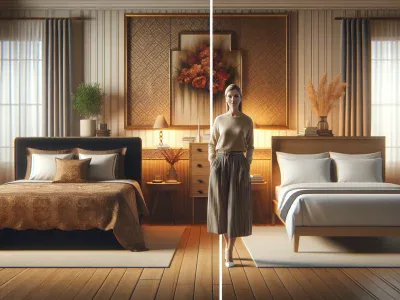King vs California King: Key Differences, Pros & Cons, and How to Choose the Right Mattress
Picture sinking into a bed so spacious you almost lose yourself in the sea of soft sheets—only to wonder if there’s something even grander out there. The quest for the perfect mattress isn’t just about comfort; it’s about finding the right fit for your space, your style, and those blissful nights when stretching out feels like a luxury.
You’ve probably heard whispers about the king and California king, but what really sets them apart? The answer isn’t as simple as inches and measurements. It’s a tale of unexpected advantages, from extra legroom for tall dreamers to the way a mattress transforms the feel of your entire bedroom. Before you make your next move, you’ll want to know which size truly rules your world.
Overview Of King And California King Beds
King and California king beds both occupy premium space in the bedroom, but each master size brings unique attributes. King beds, measuring 76 inches wide and 80 inches long, offer the widest horizontal sleep area—picture two people stretching out with a full 38 inches each, more space than a single twin. In contrast, California king beds, at 72 inches wide and 84 inches long, trade width for length, making them an option for people taller than 6 feet or for rooms with unique proportions.
People often picture king beds as the ultimate in luxury, conjuring rooms in upscale hotels or elegant homes where every detail matters. Picture a sprawling king mattress, generous enough for a couple and a child, plus maybe a pet or two on a lazy Sunday. Some owners favor this size because the sprawl feels liberating, similar to waking on the edge of a meadow rather than a crowded park. The dependency between your body space needs and your sleep satisfaction often feels most acutely met with a standard king, especially if you like to spread out.
But the California king has its own compelling narrative. Former Lakers player Wilt Chamberlain reportedly commissioned a special long mattress in the 1960s, sparking the popularity of the California king across celebrity homes in Los Angeles. You’ll see California king beds favored in contemporary designs, lofts with high ceilings, and luxury condos where proportion and dramatic visuals play as much a part as comfort. If your feet routinely dangle off the bed, you might see the extra 4 inches of length as an answer to a persistent problem. Anyone who’s lived in converted urban spaces might agree: a California king fits rooms that stretch out rather than merely expand.
Both sizes cost more than queen beds, starting around $1,000 for quality models (source: Sleep Foundation, 2023). King and California king beds come with distinctive linen and frame requirements, and moving either can turn sofa-lugging into a comparatively easy task. Major retailers, including Saatva, Tempur-Pedic, and Casper, stock both sizes, though king remains slightly more popular nationwide.
Here’s a data snapshot for quick comparison:
| Bed Type | Width (inches) | Length (inches) | Main Advantage | Typical Use Case |
|---|---|---|---|---|
| King | 76 | 80 | Maximum width | Couples wanting extra elbow-room |
| California King | 72 | 84 | Extra legroom for tall users | Tall individuals, large or long bedrooms |
Ever compare the feeling of a king bed with a California king? Some couples argue over whether width or length matters most—one likes their own space, other values full-body sprawl. If you share a bed with a large dog, the extra floor space of a king may avoid nightly territory disputes. In contrast, solo sleepers or pairs well over six feet, who hate cold toes, often swear by the California king, even if the sheets are a tad harder to find.
Choosing between these beds asks: do you prioritize closeness and shared comfort, or do you crave a royal stretch with no corners cut short? For any bedroom, their respective dimensions define its center, reflecting how you view luxury, intimacy, and the importance of uninterrupted rest.
Key Differences Between King And California King
A king vs. California king debate isn’t just about inches—it’s about personalities, households, and dreams. As you choose a new mattress, dimensions echo through every corner of your bedroom, changing not just your nights but the look and feel of your space.
Size And Dimensions
A king mattress dwarfs even large furniture, measuring 76 inches wide and 80 inches long (source: Sleep Foundation). In contrast, a California king stretches out at 72 inches wide but 84 inches long, resembling a runway for those who needs more length. Picture tossing and turning on a king bed: elbows and knees have acres to roam. Picture a California king—your toes could finally rest easy, especially if you’re 6’2″ or taller. While four inches might seem small, they redraw the boundaries between a cozy snuggle and a luxurious sprawl.
Room Suitability
A king mattress, wide and imposing, dominates master bedrooms measuring at least 12×12 feet because anything smaller feels cramped. Place a California king in a longer, narrower room and suddenly everything fits—doorways open better and furniture breathes. If you own a historic brownstone with odd corners, the California king’s slender silhouette might even seem tailor-made. Would your bedroom invite in light and space or embrace the plush embrace of luxury? That’re the decisions this difference shapes for you.
Comfort And Sleeping Capacity
A king’s width generously accommodates two adults and even leaves space for a child or pet sneaking in at dawn. California king, while offering less width, triumphs for solo sleepers who crave legroom or couples who loves to sleep without ever brushing feet. Athletes and anyone standing over six feet becomes loyal to the extra four inches down south (source: Better Sleep Council). The right mattress transforms nightly battles for space into peaceful, uninterrupted sleep—unless your cat insists otherwise.
| Mattress Size | Width (inches) | Length (inches) | Best For | Bedroom Size |
|---|---|---|---|---|
| King | 76 | 80 | Couples with kids or pets | 12×12 feet minimum |
| California King | 72 | 84 | Tall individuals, narrow rooms | 12×14 feet minimum |
Pros And Cons Of Each Mattress Type
Choosing between a king and a California king isn’t just about inches, it’s about sculpting the nightly backdrop of your life. Each mattress type launches its own story, like a stage set for your rituals, relationships, and dreams.
Advantages Of King
A king bed brings expansiveness to your sleep experience, stretching 76 inches wide—wider than most love seats. You’ll feel like you’ve reserved a personal island, your partner lounging feet away, your pets sprawled like royalty at your feet. This width means less accidental elbow contact for co-sleepers, especially when kids or pets join. In a shared bed, more width equates to better sleep quality, with sleep studies noting up to 25 percent fewer nighttime disturbances for couples in larger beds (Sleep Foundation, 2023).
King beds get used in primary bedrooms that double as private retreats, with their breadth making an instant statement of luxury. Sheet shopping goes simpler, since king bedding and accessories be plentiful at both discount stores and designer boutiques. In family movie nights, wide king mattresses serve as plush theater seats, accommodating three or four bodies in a popcorn-piled sprawl.
Ever wondered if more space really makes a difference? In a survey by Better Sleep Council, respondents with king beds reported feeling more well-rested compared to those with narrower mattresses. It’s almost as if the extra space shapes your sense of peace—transforming squabbles over sheets into harmonious dreams.
Advantages Of California King
A California king mattress brings length—a stretched canvas for the especially tall, or anyone who sleeps like they’re running a marathon. At 84 inches long, it rivals a limousine’s interior, where even 6-foot-5 athletes can lie back without curled toes dangling off the edge. You’ve probably seen celebrity bedrooms flaunting California kings; Marilyn Monroe and Shaq both favored this extra-long silhouette.
This mattress type fits rooms where length outpaces width, as in converted lofts or urban condos with panoramic windows. Its shape anchors a room visually, adding an elegant line that draws the eye across hardwood floors and sunlit rugs. If your dog loves snoozing at your feet, or if kids habitually slide in for weekend cuddles, nobody’s left hanging off the end.
Yet, buying sheet sets or moving a California king proves challenging—manufacturers produce fewer styles, and maneuvering the length through stairwells feel’s like solving a mini-puzzle. Still, for the right sleeper, that additional stretch is priceless. Picture waking up, stretching your arms and legs, and touching nothing but cloudlike cotton—your own private runway for dreaming.
Which fits: are you after generous elbow room and furniture-store abundance, or do you crave a sleeping canvas that celebrates every inch of your lengthy frame? Each mattress type whispers a different story, one wide, one long—each sculpting sleep in its unique dimensions.
Choosing The Right Bed For Your Needs
Matching a bed to your needs or space shapes every night’s story, not just a shopping list. Picture your master suite: sunlight pouring in, walls echoing with family laughter or quiet nighttime whispers. The king and California king rarely settles for the same “fit”—each frame traces its own narrative arc.
Think about space. Your king mattress wants room to spread out, demanding at least a 12×12-foot area. Squeeze it into a smaller room, and suddenly those grand dimensions feels more like a crowd than a luxury. If you’ve got a converted loft or a vintage Craftsman with an odd layout, the California king’s 84-inch length slides neatly along one wall, reclaiming precious walking space. Rebecca, a 6’2” architect in Chicago, jokes that her feet always “joined the cold” until she swapped for a Cal king; now her toes never peek past the covers.
Questions of comfort spark family debates. A king lets kids or pets tumble in for Saturday cartoons, while partners sleep undisturbed, each with their own “side” of the realm. But, if you or your partner stretch out tall—wireless tablets balanced on knees—only the California king “arena” offers that extra runway.
Storage and aesthetics enters the conversation, too. Dressers and nightstands jockey for position around a king bed, while longer but narrower mattresses open paths for reading chairs or vintage trunks. Home designers like Emily Henderson (2023) says a California king’s slim profile “drives harmony” in both boho and minimalist bedrooms, especially if your layout’s tricky.
Linen shopping unfolds another sub-plot. Most department stores stocks king sheets in abundance; Californa king sets often lurks in separate aisles or require an online hunt. Ask yourself which fits your lifestyle—the convenience of grabbing new bedding midweek or the delight of hunting for that perfect, luxurious sheet set?
Price tells its own tale. Both options, on average, start around $1,000 (Sleep Foundation, 2023). Accessories, like supportive bed frames or custom headboards, might boost costs higher for unique dimensions, especially with California king.
Don’t fills your space with just any mattress, asking which version crowns your day-to-day life. Would you rather jump into sprawling, shared space or claim the elongated haven of extra length? Each choice reshapes your havens narrative, transforming routine sleep into something tailored, intentional, memorable.
Conclusion
Choosing between a king and California king mattress comes down to what truly matters to you in your sleep space. Think about your room’s shape your height and how you want your bedroom to feel.
The right mattress isn’t just a place to rest—it’s a foundation for your nightly routine and personal comfort. Take your time to weigh your options and you’ll find the perfect fit that transforms your bedroom into a sanctuary tailored just for you.
- Understanding the Difference Between HMO and POS Health Plans: Key Insights - October 11, 2025
- Understanding the Difference Between Agonist and Antagonist in Pharmacology - October 11, 2025
- Understanding NMS and Serotonin Syndrome: Causes, Symptoms, and Treatments Compared - October 11, 2025






